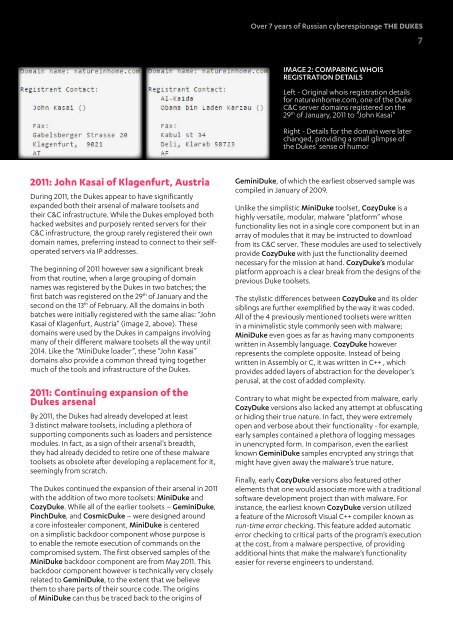THE DUKES
KfG7I6
KfG7I6
You also want an ePaper? Increase the reach of your titles
YUMPU automatically turns print PDFs into web optimized ePapers that Google loves.
Over 7 years of Russian cyberespionage <strong>THE</strong> <strong>DUKES</strong><br />
7<br />
IMAGE 2: COMPARING WHOIS<br />
REGISTRATION DETAILS<br />
Left - Original whois registration details<br />
for natureinhome.com, one of the Duke<br />
C&C server domains registered on the<br />
29 th of January, 2011 to “John Kasai”<br />
Right - Details for the domain were later<br />
changed, providing a small glimpse of<br />
the Dukes’ sense of humor<br />
2011: John Kasai of Klagenfurt, Austria<br />
During 2011, the Dukes appear to have significantly<br />
expanded both their arsenal of malware toolsets and<br />
their C&C infrastructure. While the Dukes employed both<br />
hacked websites and purposely rented servers for their<br />
C&C infrastructure, the group rarely registered their own<br />
domain names, preferring instead to connect to their selfoperated<br />
servers via IP addresses.<br />
The beginning of 2011 however saw a significant break<br />
from that routine, when a large grouping of domain<br />
names was registered by the Dukes in two batches; the<br />
first batch was registered on the 29 th of January and the<br />
second on the 13 th of February. All the domains in both<br />
batches were initially registered with the same alias: “John<br />
Kasai of Klagenfurt, Austria” (image 2, above). These<br />
domains were used by the Dukes in campaigns involving<br />
many of their different malware toolsets all the way until<br />
2014. Like the “MiniDuke loader”, these “John Kasai”<br />
domains also provide a common thread tying together<br />
much of the tools and infrastructure of the Dukes.<br />
2011: Continuing expansion of the<br />
Dukes arsenal<br />
By 2011, the Dukes had already developed at least<br />
3 distinct malware toolsets, including a plethora of<br />
supporting components such as loaders and persistence<br />
modules. In fact, as a sign of their arsenal’s breadth,<br />
they had already decided to retire one of these malware<br />
toolsets as obsolete after developing a replacement for it,<br />
seemingly from scratch.<br />
The Dukes continued the expansion of their arsenal in 2011<br />
with the addition of two more toolsets: MiniDuke and<br />
CozyDuke. While all of the earlier toolsets – GeminiDuke,<br />
PinchDuke, and CosmicDuke – were designed around<br />
a core infostealer component, MiniDuke is centered<br />
on a simplistic backdoor component whose purpose is<br />
to enable the remote execution of commands on the<br />
compromised system. The first observed samples of the<br />
MiniDuke backdoor component are from May 2011. This<br />
backdoor component however is technically very closely<br />
related to GeminiDuke, to the extent that we believe<br />
them to share parts of their source code. The origins<br />
of MiniDuke can thus be traced back to the origins of<br />
GeminiDuke, of which the earliest observed sample was<br />
compiled in January of 2009.<br />
Unlike the simplistic MiniDuke toolset, CozyDuke is a<br />
highly versatile, modular, malware “platform” whose<br />
functionality lies not in a single core component but in an<br />
array of modules that it may be instructed to download<br />
from its C&C server. These modules are used to selectively<br />
provide CozyDuke with just the functionality deemed<br />
necessary for the mission at hand. CozyDuke’s modular<br />
platform approach is a clear break from the designs of the<br />
previous Duke toolsets.<br />
The stylistic differences between CozyDuke and its older<br />
siblings are further exemplified by the way it was coded.<br />
All of the 4 previously mentioned toolsets were written<br />
in a minimalistic style commonly seen with malware;<br />
MiniDuke even goes as far as having many components<br />
written in Assembly language. CozyDuke however<br />
represents the complete opposite. Instead of being<br />
written in Assembly or C, it was written in C++ , which<br />
provides added layers of abstraction for the developer’s<br />
perusal, at the cost of added complexity.<br />
Contrary to what might be expected from malware, early<br />
CozyDuke versions also lacked any attempt at obfuscating<br />
or hiding their true nature. In fact, they were extremely<br />
open and verbose about their functionality - for example,<br />
early samples contained a plethora of logging messages<br />
in unencrypted form. In comparison, even the earliest<br />
known GeminiDuke samples encrypted any strings that<br />
might have given away the malware’s true nature.<br />
Finally, early CozyDuke versions also featured other<br />
elements that one would associate more with a traditional<br />
software development project than with malware. For<br />
instance, the earliest known CozyDuke version utilized<br />
a feature of the Microsoft Visual C++ compiler known as<br />
run-time error checking. This feature added automatic<br />
error checking to critical parts of the program’s execution<br />
at the cost, from a malware perspective, of providing<br />
additional hints that make the malware’s functionality<br />
easier for reverse engineers to understand.


